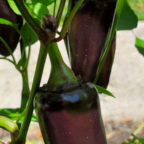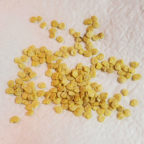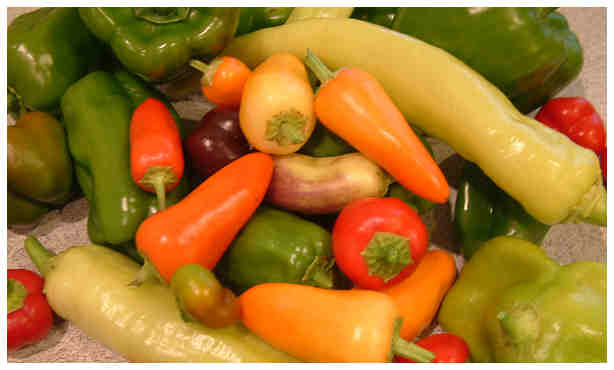Growing Peppers in Containers, Part 2
This is an update to my original growing peppers in containers post, as it’s been awhile since I did the original post. I’ve tried a few different techniques, and a few new products, so I want to offer more tips.
In addition to the tips for standard container growing, I’m also going to talk a little about intensive container growing.
Container Size
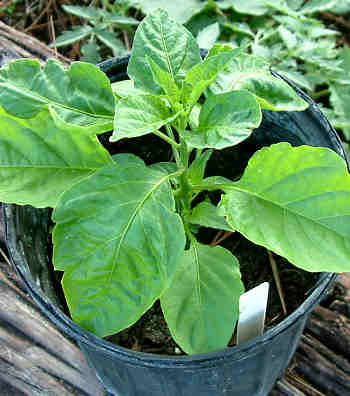
A Bhut Jolokia plant, almost ready to be put into its final container home.
I know I originally said that you could use a 2 gallon pot for the small (under 12 inches fully grown) peppers. While that is still true, I’m erring more on the side of giving the plant room to grow. Now I’ll say a 3 gallon pot for the smallest peppers and 5 gallon pots for an average size pepper.
The ones that can threaten to take over the garden with their potential size (jalapenos come to mind), I’d go with a 7 gallon if you want to limit the size a bit, but still keep a good harvest. Then if you want to let the plant really grow and then cage it (like with a tomato cage), then use a 10 gallon container.
You can also think about using a really big container (like 20 or 25 gallons) and putting multiple plants in it. For example, maybe something like a super-hot pepper in the middle, with some smaller ornamental (no heat) peppers around it. That way you get your hot-hot-hot peppers growing, but you don’t have to worry so much about brushing up against it an getting the hot oils on your skin or clothing. Plus, it looks really nice!
Intensive Growing
I’m also experimenting with a more intensive-type of a growing setup. I believe in giving the plants what they want to thrive (like sunshine, water and organic fertilizer). My fertilizers of choice are fish emulsion and kelp/seaweed emulsion. Still, I got to wondering if I could still be organic (or at least mostly organic), yet still increase my harvest — without increasing container size?
So, I’ve done some research and am setting out to run some tests on growing multiple plants — multiple of the bigger plants — in a single 20 gallon container. I’ve ordered my soil amendments (worm castings and Azomite
), and will be mixing it in with my potting soil / compost mix. If you’re looking for more info, check out my post on soil amendments.
Think of it as organic square foot gardening…without the squares. In any case, I’ll keep you posted on how it works.
Container Material
I really didn’t discuss this previously, as all I mostly used plain black plastic pots. But, there are other kinds of containers out there, so let’s talk about them.
Clay pots can be glazed (shiny) or unglazed (matte). Terracotta pots are what most people think about when they hear “clay”. If you use a glazed clay container, it must have holes in the bottom so that water can drain out; otherwise, you run the risk of drowning your peppers as glazed clay doesn’t “breathe”!
Unglazed pots should still have a drainage hole, but because the clay allows air to pass in, there is more air circulation for the roots — a good thing. The not-so-good side is that unglazed clay containers are notorious for drying out fast, so you will very likely have to water more often.
Self-watering containers are out on the market, and a lot of people swear by them. I have a friend who uses the Earthbox self-watering containers and she loves it (and grows some awfully nice veggies). She keeps it on her back patio, so has easy access to it. They are a bit on the pricy side, but I just bought one anyway, to put in the greenhouse — I am curious how it will stack up against some of my other kinds of containers that will be there. As an FYI, the Earthbox containers use 2 cubic feet of soil — that’s about a 15 gallon size. (1 cubic foot equals just shy of 7.5 gallons).
There are also more traditional self-watering planters, with a smaller size. It’s just a wee bit difficult to know exactly how much soil these hold, without knowing for sure how much space the soil has versus how much of the container is for the water. When in doubt, go bigger. A 14 inch diameter is the smallest I (personally) would go.
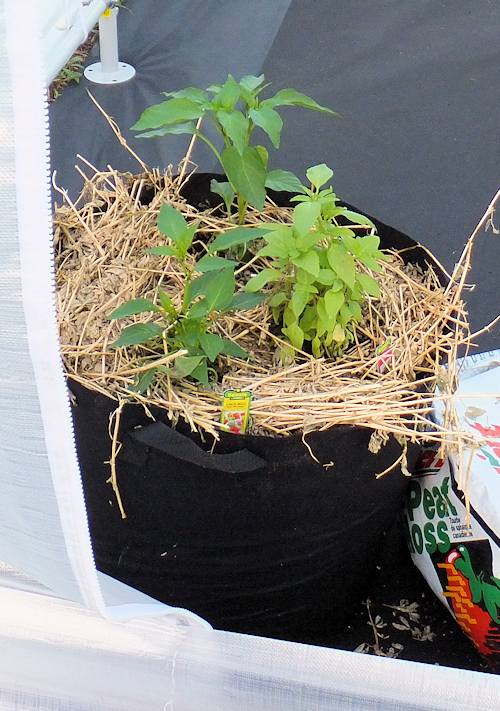
Here is a grow bag / smart pot with peppers and basil. This one is the 12-gallon size.
The containers known collectively as “grow bags” or “grow tubs” are made of a material that kind of feels like a very thick felt. They are also called “Smart Pots“. The material is breathable, so lets oxygen in, like unglazed clay pots. However, the new material is supposed to be better at maintaining the moisture level in the soil, and it’s very definitely lighter in weight — clay is much, much heavier to move around. The grow bags are also billed as helping the plants to build a better root system, and insulating the roots better than traditional materials.
At any rate, I got myself a bunch of them, from 12 gallons all the way up to 25 gallons, to use with my peppers and tomatoes. So far I am liking the 15 gallon size the best, as I will be able to get two medium-sized peppers in one container, in less space than two side-by-side 5 gallon containers. I’ll put some of the grow bags outside in the main garden area, as well as some in the greenhouse.
And of course there is the ubiquitous plastic container. They are usually pretty inexpensive, and are light in weight (and thus easier to move when full of soil). It can be a little difficult to find the larger sizes (15 gallons and up), but a local nursery may have some they would sell you. The plain black ones will be the least expensive, while the colorful “decorator” ones will cost more. Naturally, I will have a bunch of these in the greenhouse and main garden area. And of course — always check to make sure there is a drainage hole.
